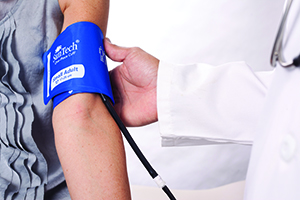![]()
Blog @ SunTech
Advice from the BP Measurement Experts
10 Factors That Can Affect Blood Pressure Readings
 Have you ever visited the doctor's office and discovered your blood pressure was higher than you expected? Most people do not realize their blood pressure is constantly changing minute by minute in response to mood, activity, body position, etc. In fact, simple changes can cause blood pressure to fluctuate between 5 and 40 mmHg. Here is a list of 10 factors that can temporarily cause significant deviations in your blood pressure measurements.
Have you ever visited the doctor's office and discovered your blood pressure was higher than you expected? Most people do not realize their blood pressure is constantly changing minute by minute in response to mood, activity, body position, etc. In fact, simple changes can cause blood pressure to fluctuate between 5 and 40 mmHg. Here is a list of 10 factors that can temporarily cause significant deviations in your blood pressure measurements.
- Blood Pressure Cuff is too Small1,3,4 - It is extremely important to make sure the proper size blood pressure cuff is used on your upper arm when taking a measurement. In fact, most blood pressure measurement errors occur by not taking the time to determine if the patient's arm circumference falls within the Range indicators on the cuff. Studies have shown that using too small of a blood pressure cuff can cause a patient's systolic blood pressure measurement to increase 10 to 40 mmHg.
- Blood Pressure Cuff Used Over Clothing1,3,4 - When having your blood pressure measured, the cuff should always be placed directly on your arm. Studies have shown that clothing can impact a systolic blood pressure from 10 to 50 mmHg.
- Not Resting 3-5 minutes3,4- To obtain an accurate blood pressure measurement, it is important that you relax and rest quietly in a comfortable chair for 3 to 5 minutes before a reading is taken. Any activities such as exercise or eating can affect your systolic blood pressure measurement 10 to 20 mmHg.
- Arm/Back/Feet Unsupported1,3,4 - When having your blood pressure measured, you should always be seated in a comfortable chair, legs uncrossed, with your back and arm supported. If your back is not supported, your diastolic blood pressure measurement may be increased by 6 mmHg. Crossing your legs has shown to raise your systolic blood pressure by 2 to 8 mmHg. The positioning of your upper arm below your heart level will also result in higher measurements, whereas positioning your upper arm above your heart level will give you lower measurements. These differences can increase/decrease your systolic blood pressure 2mmHg for every inch above/below your heart level.
- Emotional State5,6- Stress or anxiety can cause large increases in blood pressure. If you are having your blood pressure taken while thinking about something that causes you to tense up or become stressed, your blood pressure levels could significantly increase.
- Talking1,2,3,4 - If you are talking to the nurse/doctor while having your blood pressure taken, studies have shown that your systolic blood pressure measurement may increase 10 to 15mmHg.
- Smoking1,5,6- Tobacco products (cigarettes, cigars, smokeless tobacco) all contain nicotine which will temporarily increase your blood pressure, so refrain from smoking at least 30 minutes before having a blood pressure measurement taken.
- Alcohol/Caffeine4,5,6 - Alcohol and caffeine (sodas, coffee, tea, etc) consumption causes blood pressure levels to spike so stay away from alcohol/caffeine at least 30 minutes before having a blood pressure measurement taken.
- Temperature4,5 - Blood pressure tends to increase when you are cold. Therefore, if you are at the doctor's office and the room temperature is "chilly" to you, be aware that your blood pressure readings may be higher than expected.
- Full bladder1,3,4 - Your blood pressure is lower when your bladder is empty. As your bladder gradually fills, your blood pressure increases. Studies have shown that your systolic blood pressure measurements could increase 10 to 15mmHg when you have a full bladder.
From the list above, you can see that small changes in your body, environment, and activities all have a significant impact on your blood pressure measurements. Since there are several factors that influence blood pressure, it is important that medical professionals follow the AHA guidelines for taking blood pressure measurements to avoid misdiagnosis of hypertension and inappropriate prescription of anti-hypertension medications.
- Handler, Joel. The Importance of Accurate Blood Pressure Measurement. The Permanente Journal (2009) 13:3: 51-54
- Long, JM., J.J. Lynch, N.M Machiran, SA Thomas, KL Manilow. The effect of status on blood pressure during verbal communication. Behavior Science (2004) 5:2: 165-172.
- O'Brien E, R. Asmar, L Beilin, Y Imai, J. Mallion, G. Mancia, T. Mengden, M. Myers, P. Padfield, P. Palatini, G. Parati, T. Pickering, J. Redon, J. Staessen, G. Stergiou, P. Verdecchia. European Society of Hypertension recommendations for conventional, ambulatory, and home blood pressure measurements. Jounral of Hypertension (2003) 21: 821-848.
- Pickering, T.G., J.E. Hall, L.J. Appel, B.E. Falkner, J. Graves, M.N. Hill, D.W. Jones, T. Kurtz, S.G Sheps, E. J. Roccella. Recommendations for Blood Pressure Measurement in Humans and Experimental Animals: Part 1: Blood Pressure Measurement in Humans: A Statement for Professionals From the Subcommittee of Professional and Public Education of the American Heart Association Council on High Blood Pressure Research. Hypertension (2005) 45:142-161.
- http://www.faqs.org/nutrition/Hea-Irr/Hypertension.html
- http://www.infobloodpressure.com/factors-affecting-BP-readings.html
Interested in getting more SunTech news, product info, as well as
tips, tricks, and insights from BP experts?
Sign up to get fresh content delivered direct to your inbox.



